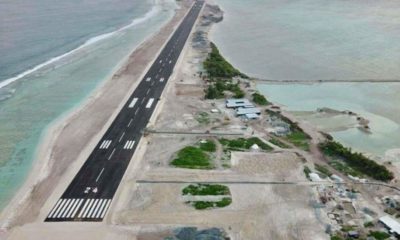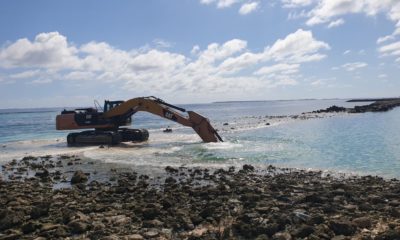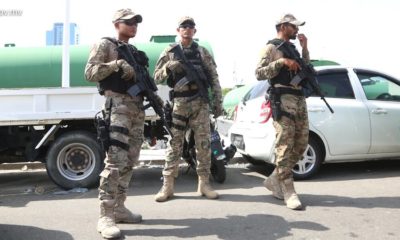Feature & Comment
Lost in translation: the story of Haveeru
Ali Rafeeq, Haveeru’s editor from 1987 – 2010, takes a look at the ownership dispute that has shut down the Maldives’ oldest newspaper.
Published
8 years agoon
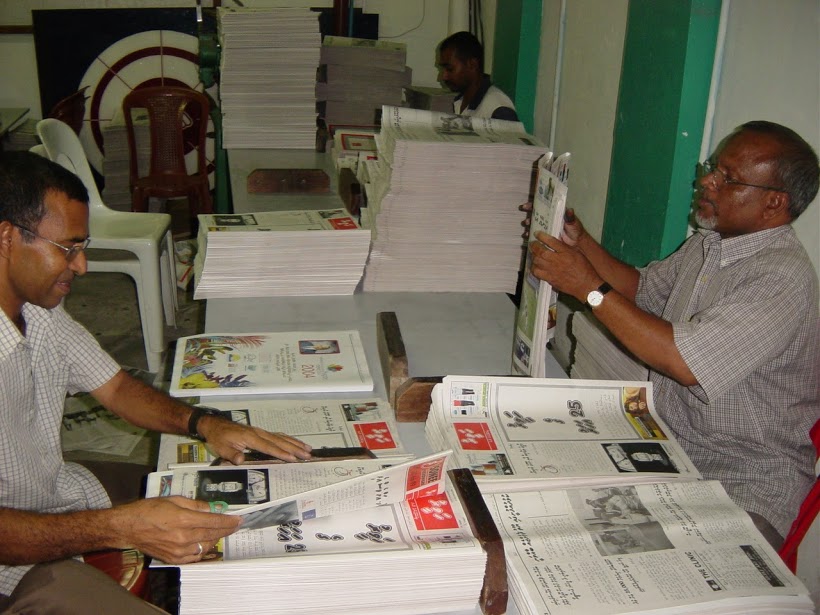
Farooq Hassan, Ibrahim Rasheed Moosa and Mohamed Naeem, three individuals who worked part-time for Haveeru in the early 1980s have won a claim to the Maldives’ leading independent paper, some 30 years after leaving it. They are now saying: “Haveeru is a tree that we planted and grew.” This is the most preposterous claim I have heard in recent times.
Their ownership claim was based on a 1983 document that set up a news agency, the Haveeru News agency.
As someone who has worked in Haveeru since 1983, I have a responsibility to tell Haveeru’s readers, and the public what I know, and what I have witnessed. Having served as the paper’s editor from 1987 – 2010, I have seen its operations at many levels, from the very early days, long enough to know how it came to be the most trusted news brand in the Maldives. I was also the editor of Haveeru Online, the country’s first news website, launched on January 1, 1997.
When the newspaper Haveeru was launched on January 1, 1979, its founder was Dr. Mohamed Zahir Hussain. Mr. Abdullah Sodiq served as the paper’s editor, and Novelty Printers printed the paper in offset until March 1981.
Haveeru Online is not an extension of Haveeru. It was registered as a separate online publication at the Ministry of Information with Dr. Zahir as its chairman.
In 1983, I was a contributor, and part-time reporter often assigned to cover visits of foreign diplomats to the Maldives. As a rookie reporter, I was always looking for insights and inspirations from the senior editors; some tips and guidance to hone my journalism skills, but none came from those who are now claiming they were behind making Haveeru a modern, top-notch newspaper. They can be forgiven for being poor mentors; they did not have any formal journalism training or background. I have not seen any enterprising reporting from them, except the translation of foreign news content either from Arabic, English or Urudu. In those early days, local news was churned out mainly from government information subsidy; features and in-depth stories were largely translations of foreign editorial content. Journalism was more a literary discourse than an outlet for serious news reporting and analysis of local events and issues.
What is the Haveeru News Agency?
The answer is in the name: it was a news agency to wholesale news text to media outlets in the Maldives and overseas. In the 1970s and 1980s news agencies were seen as important platforms for the formation of media identity around the world, especially in developing countries. There were either state controlled or independent news agencies that continuously delivered news content to media outlets. The Associated Press, Reuters, AFP and UPI were known as the “Big Four” international news agencies. There were many regional and national news agencies – Bernama, Antara, Non-Aligned News Agency, TASS – to name a few. Haveeru also built ties with Kuwait News Agency in order to source foreign news content. News agencies were fashionable media services then, as the transnational information flow was mainly from centre to periphery and developing countries have always complained of this imbalance.
News agencies are wholesalers of news to print and broadcast media outlets. In the 1980s, news agencies – international, regional or local — were not in the business of retailing content to media consumers. Similarly Haveeru News Agency was setup to distribute news under the relevant government guidelines. The regulation on “Operations of News Agency” issued by the Department of Information and Broadcasting in 1983 clearly shows that news agencies could only be set up to transmit editorial content overseas and provide or distribute content to local newspapers, magazines, TV and radio. News agencies could not own newspapers or magazines.
If someone wanted to publish a newspaper or a magazine, an application had to be filed under “Regulation on Newspapers and Magazines.” None of the 13 articles in the regulation concerning the registration of a news agency states that a news agency could publish newspapers and magazines, or run TV and radio stations. Like any other real news agency, Haveeru News Agency, according to the regulation, was only allowed to distribute news to media outlets, globally and locally. Given this clear government guideline on the operation of news agencies, it is evident that Haveeru News Agency was set up to provide editorial support services for Haveeru.
However, Haveeru News Agency did not function as it was intended. At the outset, it did not fully comply with the government guideline on news agencies. It was perhaps too ambitious, and given technical and operational challenges the Haveeru News Agency did not practically take off. It was just a news agency on paper. No stories were filed.
Differences in views among those who signed the Haveeru News Agency “agreement,” as to the operations of Haveeru, led some of them to end their services as early as 1985. As far as I know by 1985 Rasheed, Farooq, Mohamed Naeem had left Haveeru, and were no longer involved in any work, editorial or otherwise, of the paper. A former staff who worked for the paper in the 1980s told me that the three of them were paid for their contributions monthly.
From offset to Gestetner 360
From April 1981, Haveeru regressed in terms of production – from offset to a Gestetner 360 printing. While offset is a high quality printing technology, printing by a Gestetner machine is like going back to the Guttenberg press. Gestetner 360 is a hand-operated machine that could print Haveeru in A4 paper. Photo reproductions were not as clear as in offset printing. Dr. Zahir, as the paper’s chairman, believed strongly that he had to overcome technical challenges, and develop Haveeru to a reputable and aesthetically well-designed publication. Setting up a quality printing press was his priority. Given the huge investment needed to set up a quality printing press, he sought funds through loans, and by 1986, he was able to procure an offset printing press. With new printing technology, the paper’s size increased from A4 to tabloid size: new layout and redesigns were implemented. Readers as well as advertisers welcomed the new look and print quality – clear photos, better layout and quality newsprint.
Intensive research and planning
It did not happen just like that. The level of editorial integrity and professionalism, newspaper production and digital journalism that we see in the Haveeru newspaper and Haveeru Online today are results of years of planning, days of research, and huge investments in technology and humans resources. More systematic approaches to newspaper publishing and production were used after 1990. Regular editorial meetings were held, journalists were trained through in-house training programmes and some were sent for overseas. Human resources development was a key area of focus, as part of a larger strategy to make Haveeru a reputed and credible media outlet in the country.
Dr. Zahir had the foresight that print journalism would decline in the course of time, and that the future was in online journalism. To realise this, I as editor, worked on several projects one of which was HaveeruNet. This was a Bulletin Board System setup in 1994 and it was used as a platform to share news from Haveeru, including foreign news content from the AFP news agency. This was two years before the internet was launched in the Maldives. HaveeruNet became popular and there were more than 150 subscribers to the service by 1995. Users connected to HaveeruNet with dial-up connection using a modem. The next logical step was to launch Haveeru Online on January, 1 1997 – that was just a year after the New York Times implemented its website. From a very basic static website, Haveeru Online has over years become one of the most sophisticated and interactive local news websites in terms of content, design and engineering.
Technology and innovation are not the only areas of focus in Haveeru’s well-planned development. Support for staff was given priority; a provident fund was established long before the government made it mandatory on employers. Regular training and professional development programmes were part of the larger scheme to develop a competent workforce of reporters, editors, managers, developers, technicians and printers. Social activities among the staff also added to strengthen the close relations among the staff – a kind of close-knit Haveeru family was the result. Following are some key developments since 1986:
- Setting up new offset printing facility
- Computerisation
- HaveeruNet and Haveeru Online
- Five-year plans
- Staff training and professional development programmes
- News management system – Haveeru Multimedia Information System. This speeded up editorial workflow, helped reporters to access a digital archive of news text and photos
- Regular editorial meetings to review content, plan new projects
- Redesigns of the newspaper – several times over the years to reflect modern newspaper design trends.
- Redesigns of the Haveeru website to reflect design changes, reader preferences and interactive technology.
The above are just few of the major strategies and actions taken for Haveeru’s development under Dr. Zahir’s chairmanship. The Haveeru News Agency agreement, which had its own flaws in the setup and operations, I believe, cannot be taken as a basis to take away what someone has invested in so heavily financially and intellectually.
Inconsistency in translating or difficulty in understanding what a news agency may have also further complicated the issue. But if we look at the guidelines issued by the then government media oversight agency – Department of Information – we can clearly see that news agencies have very distinct roles compared with that of print media.
Media users in the Maldives have lost a credible news source with the cease in publication of Haveeru newspaper, and Haveeru Online. The free press in the Maldives is under enormous pressure, and developments in recent months have shown that more challenges are to come. However, it is unlikely that the younger generation of progressive journalists could be intimidated into giving up their constitutional right to press freedom. What is apparent, in this disruptive phase of journalism in the Maldives, is that journalism in the public sphere will also thrive, and face challenges, to create a better democratic society. It is unlikely that the news media will become complacent in playing their role as the fourth estate. I believe that mainstream and alternative media will continue to question public officials to make them accountable, investigate social and political issues.
Ali Rafeeq is the former editor of Haveeru and Haveeru Online.
All comment pieces are the sole view of the author and do not reflect the editorial policy of The Maldives Independent. If you would like to write an opinion piece, please send proposalsto [email protected]
Related Posts
 Children of Haveeru founder launch counterclaim in ownership battle
Children of Haveeru founder launch counterclaim in ownership battle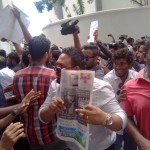 Supreme Court throws out Haveeru ownership appeal
Supreme Court throws out Haveeru ownership appeal Court splits Haveeru ownership
Court splits Haveeru ownership Court order sought to prevent Haveeru staff from registering new paper
Court order sought to prevent Haveeru staff from registering new paper Court blocks Haveeru staff from registering new paper
Court blocks Haveeru staff from registering new paper High court hears challenge to work ban on ex Haveeru staff
High court hears challenge to work ban on ex Haveeru staff

Maldives Independent suspends operations

Iyaz on Female Circumcision

EPA rejects Maafaru runway expansion project

Infrastructure development pushing islands to ‘tipping point’




